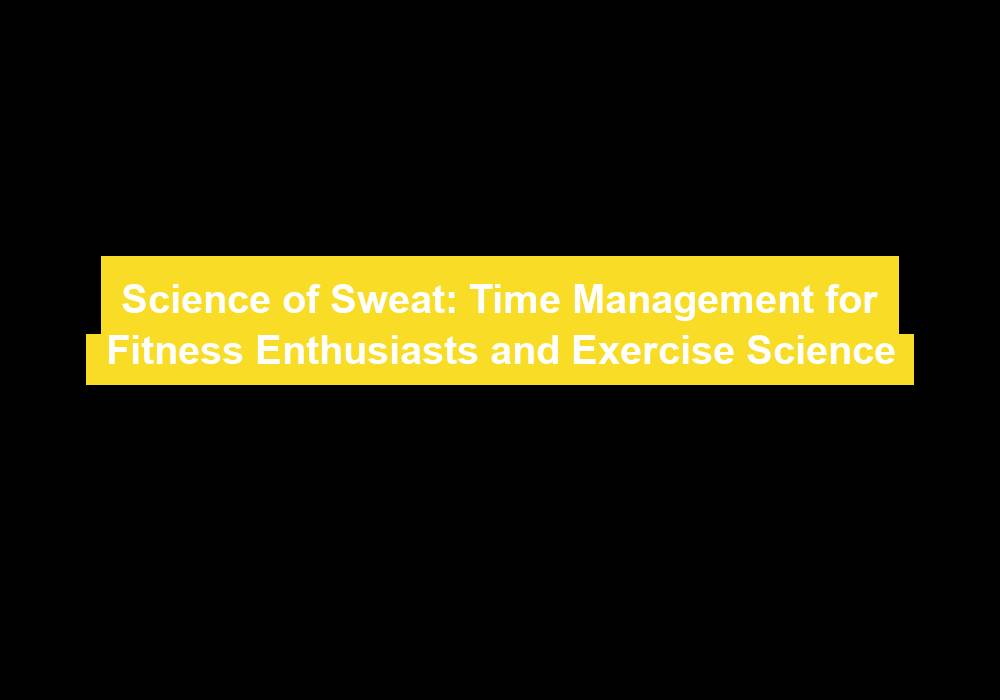Science of Sweat: Time Management for Fitness Enthusiasts and Exercise Science
YouG??ve probably experienced the challenge of balancing your fitness routine with the demands of your daily life. But what if there were a scientific approach to optimizing your workouts and managing your time more effectively? Understanding the science of sweat and its impact on exercise can not only enhance your fitness performance but also help you make the most of your limited time. As you explore the connection between sweat, time management, and exercise science, youG??ll uncover practical strategies that could revolutionize the way you approach your fitness journey.
Understanding Sweat Composition
When you exercise, your body sweats as a result of the thermoregulatory systemG??s attempt to maintain a stable core temperature. Sweat is primarily composed of water, but it also contains various electrolytes such as sodium, potassium, calcium, and magnesium. These electrolytes play a crucial role in maintaining the bodyG??s fluid balance and are essential for proper muscle and nerve function.
Sweat is produced by sweat glands, which are distributed all over your body. The two main types of sweat glands are eccrine and apocrine glands. Eccrine glands are the most numerous and are responsible for producing the sweat that helps regulate body temperature. On the other hand, apocrine glands, found in areas with a high concentration of hair follicles, produce a thicker secretion that is odorless when first released but can develop an odor when it comes into contact with bacteria on the skinG??s surface.
As you exercise, your sweat rate and electrolyte loss can vary depending on factors such as the intensity of the exercise, environmental conditions, and individual differences in sweat composition. ItG??s important to replenish both water and electrolytes lost through sweating to maintain hydration and support optimal physiological function.
Understanding the composition of sweat and how sweat glands function can help you make informed decisions about hydration and electrolyte replacement strategies to support your exercise routine. By paying attention to your bodyG??s sweat patterns and adjusting your fluid and electrolyte intake accordingly, you can optimize your performance and overall well-being.
Impact of Exercise Duration
The duration of exercise significantly impacts the rate of sweat production and electrolyte loss, which are critical factors to consider for maintaining hydration and supporting optimal physiological function during physical activity. Understanding how exercise duration affects sweat production and electrolyte loss is crucial for designing effective hydration strategies and preventing dehydration-related issues. HereG??s a closer look at the impact of exercise duration on sweat production and electrolyte loss:
-
Exercise Intensity: The higher the exercise intensity, the more sweat your body produces. When the duration of high-intensity exercise increases, so does the volume of sweat produced, leading to a higher rate of electrolyte loss.
-
Sweat Duration: Longer exercise durations result in extended periods of sweating, leading to greater overall fluid and electrolyte loss from the body. Prolonged sweating can significantly impact hydration levels and electrolyte balance, which are essential for optimal physical performance.
-
Hydration Strategies: Understanding the impact of exercise duration on sweat production helps in developing personalized hydration strategies. Tailoring fluid intake based on the duration of exercise can help maintain hydration levels and support performance during prolonged physical activity.
-
Electrolyte Replacement: Longer exercise durations necessitate a greater focus on electrolyte replacement. The impact of extended exercise duration on electrolyte loss underscores the importance of replenishing sodium, potassium, and other essential electrolytes to support physiological function and prevent dehydration-related complications.
Consider these factors when planning your exercise routines to ensure adequate hydration and electrolyte balance, especially during longer durations of physical activity.
Time-Efficient Workout Strategies
To optimize your workouts within limited timeframes, consider integrating high-intensity interval training and compound movements for maximum efficiency and effectiveness. High-intensity interval training (HIIT) involves alternating between short bursts of intense exercise and brief periods of rest or lower-intensity activity. This technique has been shown to significantly improve cardiovascular fitness, increase calorie burn, and enhance metabolic rate, making it an excellent choice for time-efficient workouts. Additionally, compound movements, which engage multiple muscle groups and joints simultaneously, are highly effective for maximizing workout efficiency. By incorporating these efficient training techniques into your workout regimen, you can achieve significant fitness gains even with limited time available.
| Efficient Training Techniques | Description |
|---|---|
| High-Intensity Interval Training (HIIT) | HIIT involves short bursts of intense exercise followed by brief recovery periods. It is known for its ability to improve cardiovascular fitness, boost metabolism, and enhance calorie burn. |
| Compound Movements | Compound movements engage multiple muscle groups and joints, allowing you to work more muscles in less time. These exercises are highly effective for building strength and improving overall fitness. |
Sweat Rate and Hydration
For understanding the impact of sweat rate and hydration on exercise performance, it is crucial to delve into the physiological mechanisms that regulate fluid balance in the body during physical activity. When you engage in exercise, your bodyG??s sweat rate increases to help regulate its core temperature. Here are four key factors to consider:
-
Electrolyte Balance: As you sweat, your body loses essential electrolytes such as sodium, potassium, and chloride. Maintaining the right balance of electrolytes is vital for optimal muscle function and overall performance during exercise.
-
Sweat Loss: Your sweat rate can vary depending on factors such as exercise intensity, duration, and environmental conditions. Understanding your individual sweat rate will help you tailor your hydration strategy to meet your specific needs.
-
Rehydration: After exercise, replenishing lost fluids is crucial for recovery and overall well-being. Rehydrating with water alone may not be sufficient, as it does not replace the electrolytes lost through sweat. Consuming electrolyte-rich drinks or snacks can aid in more effective rehydration.
-
Performance: Dehydration due to inadequate fluid intake can significantly impact exercise performance, leading to decreased endurance, increased perceived effort, and impaired cognitive function.
Muscle Recovery and Timing
Transitioning from the discussion of sweat rate and hydration, understanding the role of muscle recovery and the timing of interventions is essential for optimizing exercise performance and overall physical well-being. When it comes to muscle recovery, two crucial factors to consider are protein consumption and sleep quality. Protein is vital for muscle repair and growth. After exercising, your muscles need amino acids from protein to recover. Consuming protein within 30 minutes to two hours post-exercise can enhance muscle repair and growth. Aim for a combination of high-quality protein sources such as lean meats, dairy, eggs, and plant-based options.
In addition to protein consumption, sleep quality plays a significant role in muscle recovery and overall exercise performance. During sleep, the body releases growth hormone, which aids in muscle repair. Furthermore, adequate sleep contributes to glycogen restoration, which is essential for muscle energy stores. Aim for 7-9 hours of quality sleep each night to support optimal muscle recovery.
Understanding the timing of protein consumption and prioritizing sleep quality are essential components of effective muscle recovery. By emphasizing these factors, you can enhance your bodyG??s ability to repair and build muscle, leading to improved exercise performance and overall physical well-being. Remember, optimizing muscle recovery is not just about the workout itself, but also about the post-exercise period and the quality of rest you provide your body.
Integrating Science Into Fitness Schedules
Considering the scientific principles of exercise physiology and the individualized nature of fitness, integrating science into your fitness schedule is crucial for optimizing your training outcomes. This integration involves careful fitness planning and exercise scheduling to ensure that you are making the most of your time and effort. Here are some key points to consider when integrating science into your fitness schedules:
-
Personalization: Science tells us that individual differences in genetics, metabolism, and fitness levels greatly influence the effectiveness of training programs. By integrating scientific principles into your fitness schedule, you can personalize your training to suit your specific needs and goals, leading to better results.
-
Periodization: Understanding the concept of periodization, which involves varying intensity and volume of training over specific periods, can help you optimize your fitness schedule. By incorporating periodization into your exercise scheduling, you can prevent overtraining, reduce the risk of injury, and maximize your performance gains.
-
Recovery: Scientific research emphasizes the importance of adequate rest and recovery in achieving optimal fitness outcomes. By integrating science into your fitness schedule, you can strategically plan rest days and active recovery sessions to allow your body to adapt and grow stronger.
-
Monitoring and Adaptation: Utilizing scientific tools such as heart rate monitors, fitness trackers, and performance tests can provide valuable data for monitoring your progress. This data-driven approach allows you to adapt and adjust your fitness schedule based on scientific evidence, leading to continuous improvement and a sense of belonging to the scientific fitness community.
Conclusion
In conclusion, understanding the science of sweat and its impact on exercise can greatly benefit fitness enthusiasts. By incorporating time-efficient workout strategies, monitoring sweat rate and hydration, and timing muscle recovery effectively, individuals can optimize their fitness routines. Integrating these scientific principles into your fitness schedule can lead to improved performance and overall health. Remember, the science of sweat is a valuable tool for maximizing your workouts and achieving your fitness goals.







